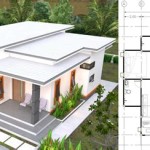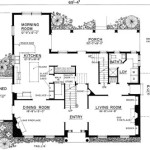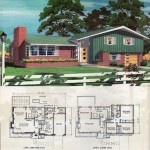Inside House Plans: A Comprehensive Guide to Understanding and Utilizing Interior Layouts
House plans, often referred to as blueprints or floor plans, are detailed two-dimensional drawings illustrating the spatial relationships within a residential structure. These plans serve as a critical communication tool between architects, builders, contractors, and homeowners, providing a clear visual representation of the building's interior configuration. Understanding the elements and nuances of inside house plans is paramount for successful construction, renovation, and interior design projects.
The primary purpose of an inside house plan is to define the layout of rooms, walls, doors, windows, and other interior features within the building's envelope. These plans convey precise measurements, dimensions, and specifications that guide construction and ensure accurate execution of the design intent. Furthermore, they aid in visualizing the flow of space, optimizing functionality, and creating a cohesive and aesthetically pleasing interior environment.
A comprehensive inside house plan will typically include several key elements: floor plans for each level of the house, elevations depicting the exterior views, cross-sections illustrating vertical relationships, and various details highlighting specific construction methods or unique design features. Understanding how to interpret these elements is crucial for effectively using the plan.
Deciphering the Components of an Inside House Plan
Inside house plans are essentially technical drawings that require a certain level of understanding to interpret correctly. Familiarizing oneself with the standardized symbols, notations, and conventions used in architectural drafting is essential for accurately understanding the information conveyed within the plan.
Floor plans are the most fundamental component of an inside house plan. They present a bird's-eye view of each level of the house, showcasing the arrangement of rooms, walls, doors, windows, and other interior elements. Walls are typically represented by thick, solid lines, while doors are illustrated as arcs indicating the swing direction. Windows are often depicted as thinner lines with a break in the middle. Furniture placement is sometimes included to provide a sense of scale and spatial relationships.
Dimensions are clearly indicated on the floor plan, usually in feet and inches or metric units, depending on the region and the plan's origin. These dimensions specify the lengths and widths of rooms, hallways, and other interior spaces. Accurate dimensions are crucial for ensuring proper construction and avoiding costly errors.
Elevations depict the exterior facades of the house from different perspectives, typically the front, rear, and sides. While primarily showing the exterior appearance, elevations also provide information about window and door placements, rooflines, and other architectural details that influence the interior lighting and spatial character.
Cross-sections are vertical slices through the house, revealing the interior construction details, such as wall heights, floor-to-ceiling clearances, and the relationship between different levels. They are particularly useful for understanding complex structural elements and ensuring adherence to building codes.
Detailed drawings focus on specific areas or elements of the house, providing larger-scale representations of intricate features, such as custom cabinetry, window details, or staircase designs. These details offer a more in-depth understanding of the construction methods and the specific materials used.
Utilizing Inside House Plans for Renovation and Remodeling Projects
Inside house plans are not only essential for new construction but also play a crucial role in renovation and remodeling projects. They provide a record of the existing structure, enabling accurate planning and execution of alterations, additions, or interior redesigns. Having an accurate inside house plan is the first step in any successful renovation project.
Before embarking on a renovation project, it is essential to obtain or create an accurate inside house plan. If existing plans are unavailable, a professional surveyor or architect can be hired to measure and document the current layout of the house. This process involves taking precise measurements of all rooms, walls, doors, windows, and other interior features.
Once an accurate inside house plan is obtained, it can be used to explore various design options and evaluate the feasibility of different remodeling ideas. Interior designers and architects can use the plan to create alternative layouts, incorporating new walls, relocating doors and windows, and reconfiguring room sizes to improve functionality and aesthetics.
Inside house plans also facilitate communication among contractors, subcontractors, and homeowners during the renovation process. They serve as a common reference point for understanding the scope of work, ensuring that everyone is on the same page regarding the design intent and construction specifications. Clear and accurate plans minimize the risk of misunderstandings and costly errors.
Furthermore, inside house plans are essential for obtaining building permits and complying with local building codes. Many municipalities require detailed plans that demonstrate compliance with zoning regulations, structural requirements, and safety standards. Submitting accurate and complete plans can expedite the permit approval process and prevent potential delays or fines.
During the renovation process, the inside house plan can be used to track progress and identify any discrepancies between the intended design and the actual construction. Regular inspections and comparisons with the plan can help ensure that the work is proceeding according to specifications and that any necessary adjustments are made promptly. This proactive approach can prevent costly rework and ensure a successful outcome.
Integrating Inside House Plans with Interior Design Principles
Inside house plans are not just technical documents; they are also valuable tools for interior design. By carefully considering the spatial relationships, dimensions, and architectural features depicted in the plan, interior designers can create functional, aesthetically pleasing, and harmonious interior spaces.
One of the key considerations in interior design is the flow of space. Inside house plans allow designers to analyze the circulation patterns within the house and optimize the arrangement of furniture, fixtures, and accessories to create a comfortable and efficient living environment. The plan enables them to visualize how people will move through the house and ensure that the layout supports their daily activities.
The dimensions indicated on the inside house plan are crucial for selecting appropriately sized furniture and avoiding overcrowding or awkward proportions. Designers can use the plan to create furniture layouts that maximize space utilization and create a sense of balance and harmony. Accurate measurements also ensure that furniture purchases will fit properly and avoid disappointment.
The placement of windows and doors, as shown on the inside house plan, significantly influences the natural lighting and ventilation within the house. Designers can use this information to optimize the use of natural light, minimizing the need for artificial lighting and creating a more inviting and energy-efficient interior. They can also consider the placement of furniture and artwork to avoid glare and maximize the benefits of natural light.
Inside house plans also provide valuable information about the architectural style and detailing of the house. Designers can use this knowledge to select complementary materials, finishes, and furniture styles that enhance the overall aesthetic appeal of the interior. They can also incorporate architectural details, such as moldings, trim, and built-ins, to create a cohesive and harmonious design.
Furthermore, inside house plans can be used to create detailed layouts for specific rooms, such as kitchens, bathrooms, and bedrooms. These layouts can specify the placement of cabinets, appliances, fixtures, and storage solutions, ensuring that the space is both functional and aesthetically pleasing. The plan also allows for the accurate calculation of material quantities and cost estimates, facilitating budget management and preventing surprises during the construction process.
In conclusion, inside house plans are indispensable tools for architects, builders, contractors, interior designers, and homeowners. They provide a clear and comprehensive representation of the building's interior layout, facilitating accurate construction, efficient renovation, and harmonious interior design. Understanding how to interpret and utilize these plans is essential for creating functional, aesthetically pleasing, and comfortable living spaces.

Pin On Small Houses

Floor Plans Types Symbols Examples

One Story House Plans With Open Concept Living Inside Country Style Small

Gorgeous Guest House Floor Plans Interior Design Ideas Alisha Taylor

How Much Do 3d House Plans Cost Faqs Answered Cedreo

Need Adu Design For Your Place If Yes We Are The Right Spot You Sksi A Leading Architectural Interior Layout House 3d Home

How To Read A Floor Plan And Design The Perfect Home For You

Floor Plan Create 2d 3d Plans Autodesk

Interior Plan Houses Stunningmesh Bedroom Decoration House Layout Plans Sims

House Design Trends What S Popular In Cur Floor Plans Extra Space Storage








